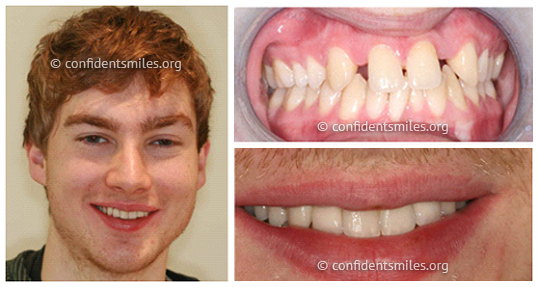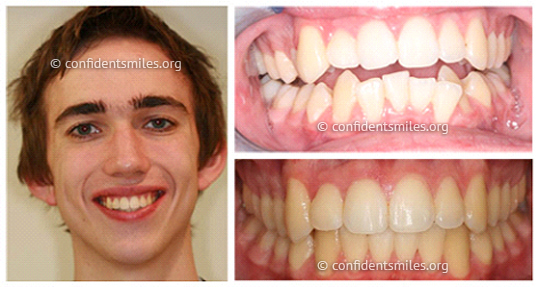Orthodontics can also be referred to as 'Teeth Straightening'.
This is a type of dental treatment that aims to improve the appearance, position and function of teeth that are crooked or out of line.
It can also help to look after the long-term health of the teeth, gums and jaw joints, by spreading the biting pressure evenly over all the teeth.
Thanks to a range of innovative new techniques, no-one, adult or child, need put up with crooked teeth and an uneven smile anymore. In the past, we have often associated braces with children, but today, age need not be a barrier to this type of treatment. Depending on the problem, treatment can be appropriate from as young as four or five years old, whilst Yasmin has also treated patients in their fifties who are delighted with their recent treatment.
Recent advances in this field mean that adults as well as children can benefit from removable or fixed braces or a combination of the two. Best of all, many straightening techniques are now very discreet or 'invisible' so you won't have to worry about your braces being too noticeable.
Advances in modern orthodontics have made the treatment much less likely to involve extracting teeth. In the past it was thought necessary to remove teeth to "make room" for the remaining teeth to be aligned, but this is now not the case.
Dr. Yasmin George has undertaken the relevant training and has considerable experience in techniques which widen the palate and broaden the jaw by means of the functional appliances, making room for all the teeth and creating broad, natural and attractive smiles. These techniques are most effective when the jaw and palate are still growing.
Orthodontic treatment periods vary from as little as 6 weeks to three years, depending on the degree of movement required and the appliances used.
Teeth may be or become badly positioned due to many factors, including:
The repositioning of the teeth can be achieved by means of braces or aligners.
Braces may be removable; for example plastic plates supporting a custom made arrangement of wires; or they may be fixed arrangements of brackets bonded to the relevant teeth and fitted with wires fixed to the brackets.
In both cases the wires apply continuous pressure to move your teeth in the desired direction; the arrangements of wires may need to be adjusted as the teeth move.
Aligners are custom-made plastic moulds or trays which fit closely over your teeth and cause the desired movements to occur gradually; you may need to wear a series of aligners over time as teeth move, to achieve the desired result.
Braces and aligners may be used in conjunction with "functional appliances", which can widen or expand the palate and jaws; with elastics, which can move teeth forwards or backwards in the jaws.
Orthodontic treatment is often most successful in children and adolescents when their jaws and faces are developing. However advances in technology are decreasing treatment times, and aesthetic improvements are making braces much less noticeable, so more adults are opting for orthodontic treatment, especially for cosmetic reasons.
Self-ligating braces are made from the same materials as traditional braces; (metal or ceramic/tooth coloured).
However instead of requiring metal or elastic ties to hold the archwire in the brackets, each bracket has a special built-in clip to hold the wire in place. This makes fitting and adjusting the braces much easier, reduces the trapping of food debris and plaque, and gives a more aesthetic effect as the brackets are typically smaller and neater.
The clip may hold the wire more or less tightly in place; if it holds more tightly, additional forces are placed on the teeth to be moved and the system is called "active". If the clip holds the wire loosely and allows it to slide, the system is called "passive".
Passive systems have less friction, lighter forces and so treatment times are reduced.
In place of stainless steel, modern orthodontics makes frequent use of nickel-titanium, which is temperature sensitive, to make archwires. The archwire is made to a perfect arch shape; it is then chilled, which makes it flexible and easily threaded through fixed brackets. Once in place, the archwire warms to body temperature and seeks to return to its original shape, creating constant light forces on the teeth.
The Damon system is internationally recognised and is in Dr George's view one of the leading appliances available. With this system also goes a 'philosophy' of treatment that requires the relevant training, and is biased towards not taking out adult teeth and looks at the face as well as the teeth.
It makes use of self-ligating brackets designed to give the archwire freedom to move freely without friction, so allowing teeth to move more quickly.
A temperature-sensitive alloy of copper, nickel and titanium is used for the archwires.
Treatment starts with very light wires which are replaced with successively larger wires as the teeth move into position. The forces involved are very light which has been shown to optimise the ability of the jaw to grow new bone to support the teeth in their new position.
A number of systems of braces have been designed to correct relatively minor misalignments of the upper and lower front teeth, as quickly as possible, and to be as discreet as possible when worn.
There are three main options: Lingual braces, tooth coloured Damon braces (similar to Six Month Smile appliances) and Aligner type applinaces such as Invisalign.
Unlike conventional braces where the brackets and wires are fixed to the visible front surface of your teeth, lingual braces put all the metalwork on the inner surface of your teeth, meaning that none of it can be seen at all. The brackets and wires are specially designed to be light, small and comfortable and not interfere with your speech.
Invisalign allows you to have straighter teeth without having to wear the traditional unsightly metal braces. Known as invisible orthodontics, this type of treatment offers you the choice of wearing a clear and sometimes removable appliance while straightening and aligning your teeth.
This is often a favourable option for adults who have professional careers and don't feel comfortable wearing unsightly 'train track' braces for several months. The technology behind invisible orthodontics is highly advanced and often gives patients a much shorter treatment time, depending on their individual cases.
It is especially important to maintain good oral hygiene while wearing braces as the wires, plates, springs, rubber bands and other appliances can trap food debris and plaque, which can stain your teeth, damage the tooth enamel and cause gum disease. Yasmin will advise you on how to keep your braces and other attachments clean but you should be prepared to brush your teeth carefully and clean between the braces and your teeth with floss or specially designed brushes after every meal.
Those fitted with a brace should continue to eat normal meals, but to prevent damage to the teeth and brace certain foods should be avoided:
Orthodontic treatment costs can vary.
This can be due the nature of the work needed, the expertise and experience of the person providing the treatment, the timescale and the expected result.
Early treatment options for children tend also not to be available in many dental practices. Yasmin offers all parents the opportunity to bring their children for a free consultation, to see what treatment options may be possible.
If it is then decided to have treatment, a full written estimate and treatment plan with payment options will be given before beginning any treatment.
When treatment is finished the teeth need to be held in position for a time. Appliances called retainers should be fitted which hold the newly straightened teeth in position while the surrounding gum and bone settles. The retainers can be removable or fixed depending on the original problem. Some retainers are worn all the time, others only at night.
Regardless of the type of treatment carried out, teeth can move over time, so proper attention should be given to retention at the emd of treatment.
Even after retention, however, it is normal for minor tooth movements to happen throughout life. No permanent guarantee can be given and retainers may need to be worn permanently to ensure long-term stability.
At Confident Smiles, all orthodontic treatment plans will include the first set of retainers.
Life benefits of orthodontic treatment

